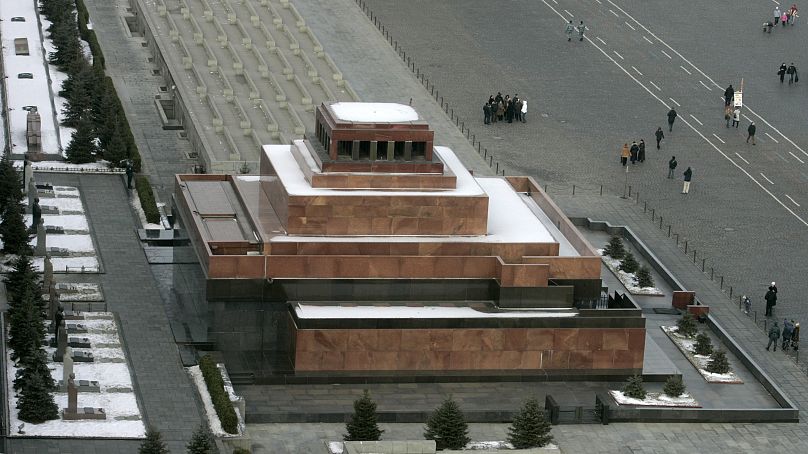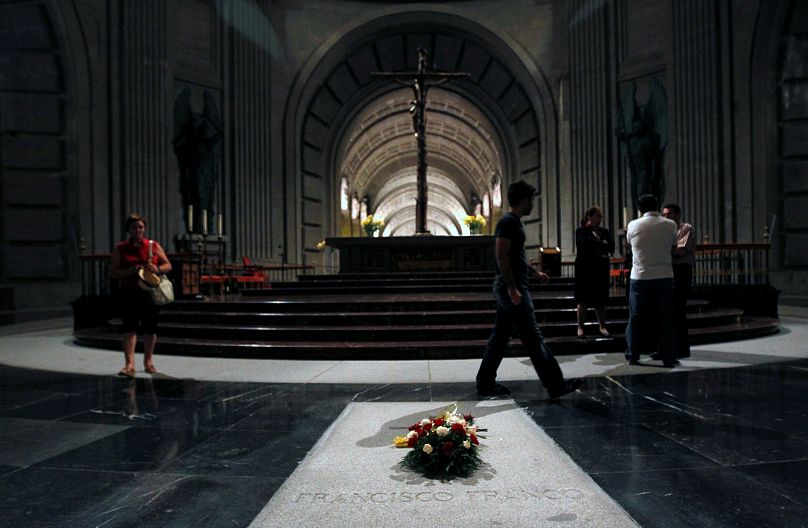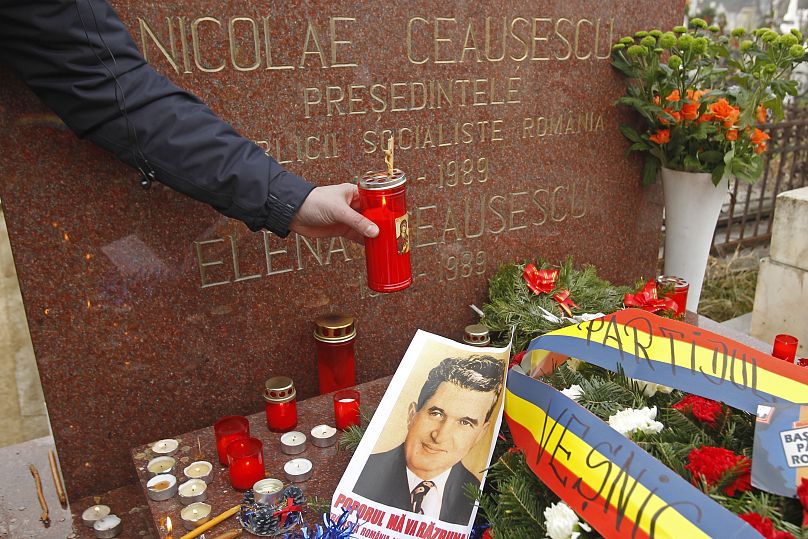With Franco's remains controversy, Euronews takes a look at the final resting places of these notorious and ruthless ex-leaders.
Spain’s new socialist government is deciding whether to remove Francisco Franco’s corpse from the Valle de Los Caídos (Valley of the Fallen) and bury it in the cemetery of El Pardo. The location of the former tyrant’s body has been a controversial topic in Spain — as it has been in other European countries where ex-dictators have died.
Euronews takes a look at the final resting places of some of the most notorious and ruthless ex-leaders in Europe.
Benito Mussolini (1883-1945), Italy
Italy’s Mussolini was the leader of the National Fascist Party who ruled from 1922 to 1945 and established a dictatorship. After trying to flee with his mistress in 1945, the two were soon captured, shot and their bodies hung upside down. The ex-leader was buried in an unmarked grave but his body was subsequently exhumed and stolen by supporters before being rediscovered by the state and laid in secret location. In 1957, he was reburied in the town he was born in, Predappio, in the San Cassiano cemetery. His grave is now a place where those nostalgic for fascism commemorate important dates and has led to funeral tourism.
Joseph Stalin (1878-1953), USSR
Stalin, leader of the Communist Party and ruler of the Soviet Union from 1924 to 1953, is known for instilling terror among the population of the USSR. Stalin died from a stroke in 1953, aged 74, at his residence outside of Moscow. He was embalmed in the Lenin Mausoleum in Moscow, however, his corpse was moved and buried 20 metres away in the Kremlin Wall Necropolis. The relocation of the body was decided by Nikita Khrushchev, one of Stalin's successors, who denounced Stalin for his crimes. Stalin's tomb is now a tourist attraction in Moscow.
Antonio de Oliveira Salazar (1889-1970), Portugal
Salazar, known for using his secret police Estado Novo to enforce repressive tactics, ruled Portugal from 1932 to 1968 as prime minister. After he suffered severe head injuries from a fall at his summer home, the Portuguese president was forced to replace Salazar as prime minister because doctors initially thought he would not survive. Two years later he died at the age of 81 from a heart attack — never knowing he was replaced as leader. He was buried in the cemetery of Vimieiro (population of 1,470), the same town where he was born, and his house was turned into a tiny museum. The public has access to both the cemetery and the museum.
Adolf Hitler (1889-1945), Germany
Hitler, backed by his Nazi Party, ruled Germany with an iron fist from 1933 to 1945. While so much is known about Hitler’s life, his death remains somewhat of a mystery. Many theories surround how he died but the most commonly held theory is that he killed himself in his bunker. Nazi aides then set a rug with the Fuhrer's body alight — but it did not fully burn and was found days later by a Soviet soldier. Hitler's remains are later believed to have been scattered around Berlin and near Rathenow by Soviets.
Francisco Franco (1892-1975), Spain
Franco, after whom a whole period of Spain’s history was named, has drawn people’s attention again, even from his tomb. After being buried for over 40 years in the Valle de Los Caídos (the Valley of the Fallen), Spain’s new socialist government is considering relocating the fascist dictator’s remains to the cemetery of El Pardo, near an old royal residence. The objective is to ensure that Valle de los Caídos remains a memorial for the civil war, not a monument to its victor.
Josip Broz Tito (1892-1980), Yugoslavia
Tito, a statesman and Yugoslavia’s communist leader from (1945-1980) was buried in the mausoleum of the “House of Flowers”, located to the south of Belgrade. He was given a state funeral, and heads of state from around the world, including the prime ministers of Spain, France, UK and Turkey, attended the funeral. His burial site, which was near where he lived in the postwar years, is now a tourist attraction, where one can find a museum, gardens and the mausoleum for the man known for repressing his political opponents and dissidents.
Philippe Petain (1856-1951), France
Petain, a former French prime minister known for his collaboration with the Nazis, was buried in the cemetery of Port-Joinville, on L’Ile-D’Yieu (population of 4,726). In 1970, his corpse was taken by a group claiming they wanted to bury him in Verdun to honour his memory, as he was known as the Lion of Verdun. Three days later, the corpse was found in Paris and brought back to the Port-Joinville cemetery. The French government arranged for flowers to be placed on his tomb for years until Jewish protests put an end to the custom. The decision was made by the president in 1993.
Nicolae Ceausescu (1918-1989), Romania
Romania’s communist leader for more than 20 years, Ceausescu, and his wife Elena were found guilty of genocide in a trial that lasted only one hour on Christmas Day in 1989. They were executed the same day. The couple were buried at a cemetery in Bucharest but their bodies were exhumed in 2010 to confirm their identities at the request of surviving relatives. Despite his regime of fear, deprivation and poverty, his tomb became a tourist attraction and a place of pilgrimage for those nostalgic for the days of communist rule.
Erich Honecker (1912-1994), East Germany
Honecker went from being a politician of the Socialist Unity Party to a hunted, jailed and exiled man at the end of his life. After trying to flee Germany and seeking refuge in Moscow at the Chilean embassy, he was put on trial in Berlin in 1992 for his suspected role in deaths at the Berlin Wall. However, he was released due to ailing health and he set off to Chile to be reunited with his family. In 1994, he died and was buried in Santiago at the Cementerio General de Santiago.
Mátyás Rákosi (1892-1971), Hungary
Rákosi, known as "Stalin's best Hungarian disciple", was Hungary's Communist leader from 1945-1956. During his time in power, he purged around 200,000 people, having them arrested, imprisoned, exiled or killed, according to the book A History of Hungary. In 1956, having been replaced by his deputy. Rakosi was forced to leave Hungary — although the official grounds for his departure was poor health — and was eventually resettled in Gorky.
Hungary's central committee in 1970 agreed to allow Rakosi to return to Hungary if he accepted conditions that included house arrest and never speaking in public — but he declined. He died in Gorky in 1971 and his ashes were "secretly returned to Hungary" 11 days later, according to the book Chess Game for Democracy: Hungary Between East and West, 1944-1947. He was buried in the Farkasréti Cemetery in Budapest in the presence of close family, his tombstone only marked by his initials.
In 2007, even these were removed to try to end persistent vandalism of the site.
Wojciech Jaruzelski (1923-2014), Poland
Jaruzelski, Poland’s last Communist leader, was known for political repression and his brutal crackdown on the Solidarity labour union when he declared martial law in 1981. Jaruzelski was buried in the military cemetery of Powaski in Warsaw. Jaruzelski’s grave is ornamented with flowers and candles, which suggests that the former leader’s family or Polish people nostalgic for the ex-leader visit the site.
Todor Zhivkov (1911-1998), Bulgaria
Zhivkov, the Communist leader of Bulgaria from 1954 to 1989, oversaw a heavy crackdown on political dissidents and human rights groups. He was buried in the Central Cemetery of Sofia. His grave has been vandalised and the bust monument stolen. A worker at the cemetery told Novinite.com that there’s usually no one to see or take care of Zhivkov’s grave.
Georgios Papadopoulos (1919-1999) and Stylianos Pattakos (1912-2016), Greece
Georgios Papadopoulos led the 1967 coup d’etat and exercised his power as leader of the junta until 1974. He died in 1999 and was buried in the A’ Cemetery of Athens.
Stylianos Pattakos, a military officer and a principal of the Greek military junta until 1974, died in 2016 at the age of 103. He was buried in his hometown Aghia Paraskevi, Crete.














